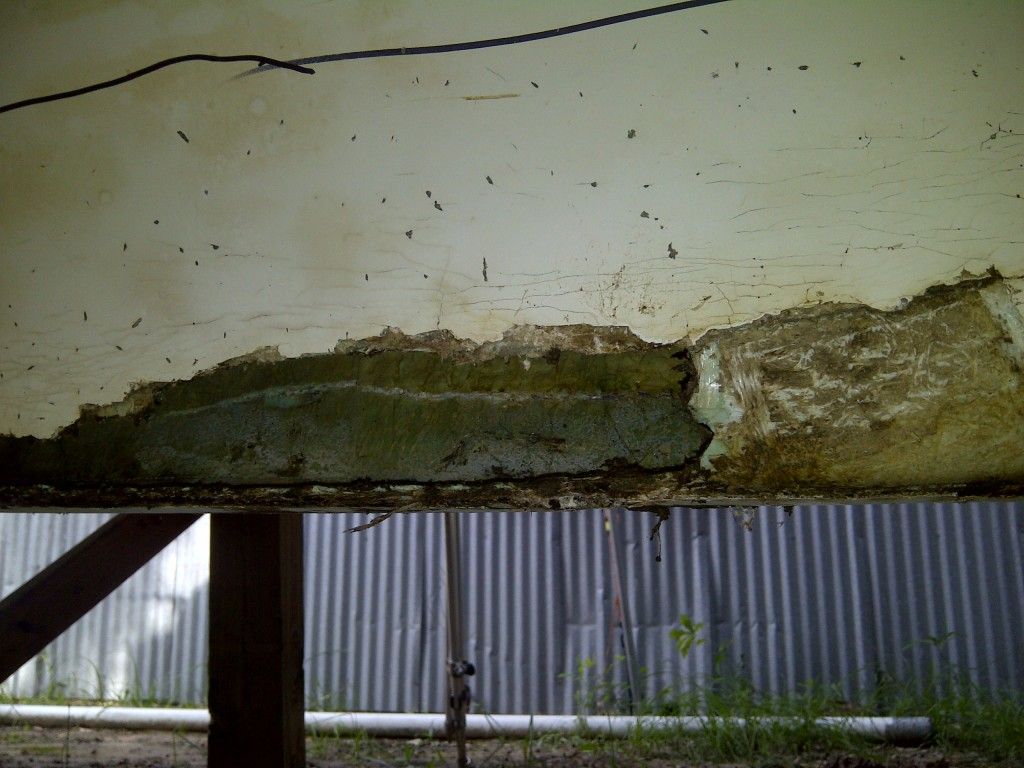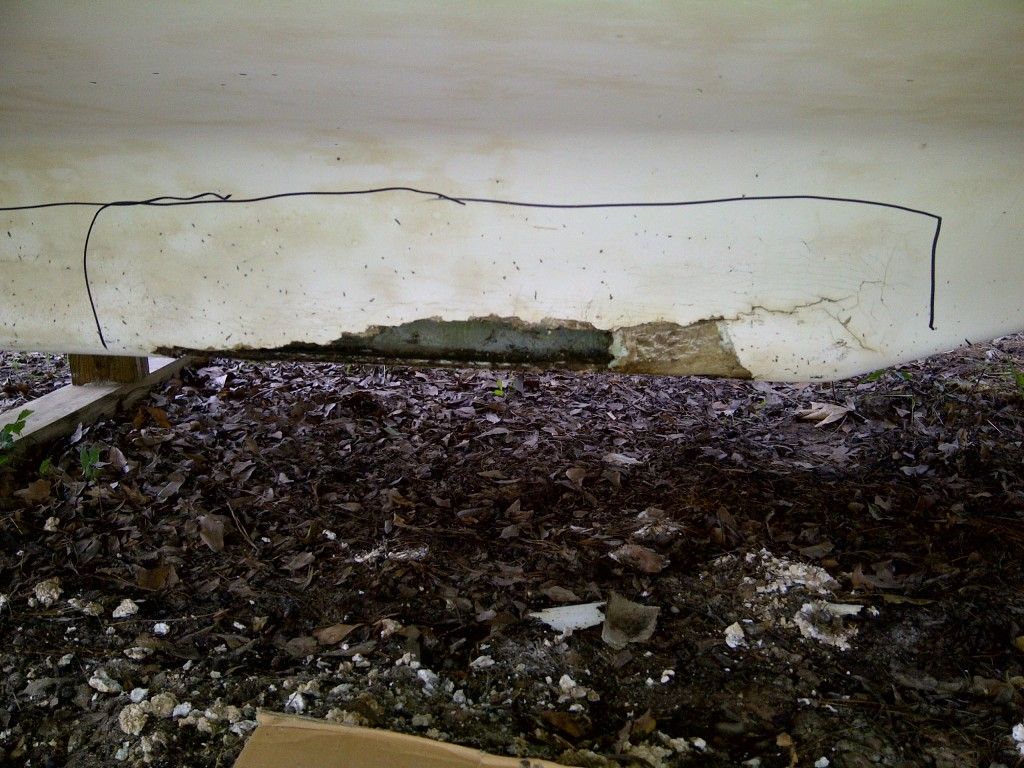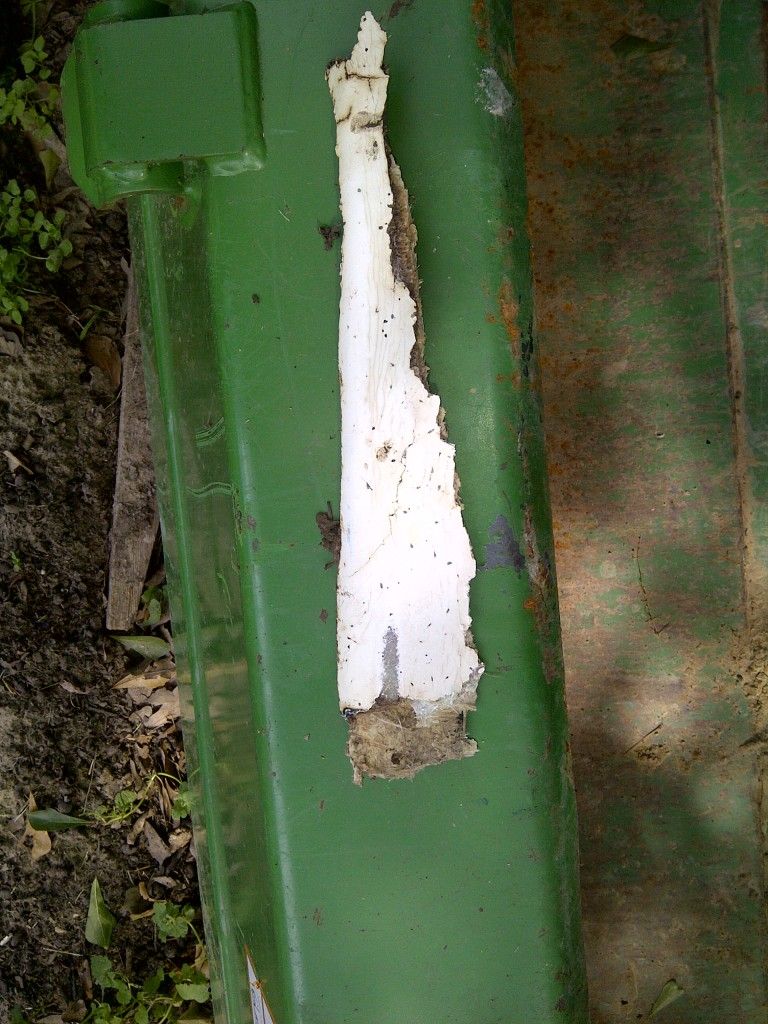The dreaded Hollow Keel - again
Moderators: BeaconMarineBob, Moderator, BeaconMarineDon
The dreaded Hollow Keel - again
I still haven't seen photos of the holes that members have opened for access to their hollow keel. I'm hauled out now, and would love to take care of this. I've read a lot of the posts, but a picture (or 2) would be really welcome.
Thanks!
Thanks!
Mel Spruill
Molly Too
'87 F32
Molly Too
'87 F32
Re: The dreaded Hollow Keel - again
try this thread, Commodave completely removed the false bilge glass and cleaned up the area, kind of makes you wonder why it was ever installed?
http://www.trojanboats.net/wforum/viewt ... e&start=15
http://www.trojanboats.net/wforum/viewt ... e&start=15
1984 Silverton 37C
Silver Lining
Scott
Silver Lining
Scott
- Away On Busine$$
- Moderate User
- Posts: 265
- Joined: Fri Feb 24, 2012 7:28 pm
- Location: Lagoon City, Lake Simcoe
Re: The dreaded Hollow Keel - again
Mine is done. Not at the boat now. What is done is just a 2.5 / 3" whole saw removal of the flat panel keel plate prior to the forward bilge area. Can't give photos till next week.
Season is short, we make the best of it.
-
larryeddington
- Ultimate User
- Posts: 1876
- Joined: Mon Sep 28, 2009 5:08 pm
- Location: Canton, TX Boat on TEXOMA
Re: The dreaded Hollow Keel - again
One thing that might be why the sealing of the keel void is for strength. On my f28 the keel is 1/4 inch glass while the regular bottom is 3/4 inch or a little better. Glassing across the top of the void makes it a structure piece. Again just my opinion.
Larry Eddington
1984 F-36 Tri Cabin "The Phoenix II"
1978 F-28 "The Phoenix"
Fish Master 2350 Bay Boat
9.5' Dink
1984 F-36 Tri Cabin "The Phoenix II"
1978 F-28 "The Phoenix"
Fish Master 2350 Bay Boat
9.5' Dink
Re: The dreaded Hollow Keel - again
When we cut out the covering fiberglass, it was only about one layer of woven roving, it had no strength. I drilled the initial hole with a screw driver and very little pressure. You could oil can the covering layer easily. The hull on the other hand is very thick. I put in a transducer this summer and it was about one inch thick near the keel. Getting rid of the covering on the hollow keel was a great thing, no more smell. I tried cleaning it by running cleaners and flushing with water first, but it was still filthy when we opened it up. It is more challenging to pump out all the bilge water since it is a narrow area now, but that is a worthwhile trade off to get rid of the smell. Now any water that might remain is not stagnant. I have a Whale brand pump with a remote pickup that I am going to install that should get almost all of the bilge water out.
Trojan has been sold
1987 President 41 DC 225 Lehmans
Au Gres, Michigan
1987 President 41 DC 225 Lehmans
Au Gres, Michigan
-
Scorpion07
- Registered user
- Posts: 73
- Joined: Sun Jan 27, 2013 10:08 pm
Re: The dreaded Hollow Keel - again
I think the only purpose for the false floor is to allow the bilge water to flow fore to aft and vise versa without pooling.
Another possible way to deal with it is to seal it better with a layer of gel coat and maybe a bilge coat paint. That way the normal flow won't be disturbed.
I'm torn myself on which way to go.
Another possible way to deal with it is to seal it better with a layer of gel coat and maybe a bilge coat paint. That way the normal flow won't be disturbed.
I'm torn myself on which way to go.
Re: The dreaded Hollow Keel - again
I just joined the forum and am reading a lot of articles. I have a smell issue in my 79 Trojan F44. Does anyone know if that has a hollow keel?
Drew
1979 Trojan F44, Detroit 6-71's
Chopped 47 Ford, 460 CI
1979 Trojan F44, Detroit 6-71's
Chopped 47 Ford, 460 CI
- aaronbocknek
- Ultimate User
- Posts: 2080
- Joined: Fri Sep 12, 2008 8:19 am
- Location: baltimore, md (alexandria, va and middle river,md) PARKSIDE MARINA
Re: The dreaded Hollow Keel - again
drew, i believe all trojans had the 'hollow keel'. my tri cabin has one but there is a mesh drain up towards the bow, under the cabin sole infront of the fwd head. i believe that this is the entry and exit point for the hollow keel to allow any water accumulated to run from front to back and vice versa. i've been in the engine room and actually tapped dead center and hear a hollow thud type of noise like my 32 had. i'm not drilling into it though as i do not, KNOCK ON WOOD, have a smell issue.
aaron
aaron
-
larryeddington
- Ultimate User
- Posts: 1876
- Joined: Mon Sep 28, 2009 5:08 pm
- Location: Canton, TX Boat on TEXOMA
Re: The dreaded Hollow Keel - again
I also have a smell issue think from hollow keel possibly. Fortunately I have the old F28 that is going in the dump. It occurred to me why not experiment on it on ways to drain it or open it up.
Larry Eddington
1984 F-36 Tri Cabin "The Phoenix II"
1978 F-28 "The Phoenix"
Fish Master 2350 Bay Boat
9.5' Dink
1984 F-36 Tri Cabin "The Phoenix II"
1978 F-28 "The Phoenix"
Fish Master 2350 Bay Boat
9.5' Dink
Re: The dreaded Hollow Keel - again
Has anyone put a drain in the keel? There is an f36 in our marina and it has one, and I was wondering if anyone put one in on an f32...Doesn't help in the water, but up on land last fall I ended up vacuming out the water when she went into storage for the winter. Not sure I got it all....
1987 Jersey Dawn
"The Other Woman II"
"The Other Woman II"
- Away On Busine$$
- Moderate User
- Posts: 265
- Joined: Fri Feb 24, 2012 7:28 pm
- Location: Lagoon City, Lake Simcoe
Re: The dreaded Hollow Keel - again
Mine has a drain! It is about 1 1/2 inches above the bottom of the keel, so if you don't block the stern high it's not of much use. Even so freeze / thaw cycles might not be all that safe.
Season is short, we make the best of it.
-
larryeddington
- Ultimate User
- Posts: 1876
- Joined: Mon Sep 28, 2009 5:08 pm
- Location: Canton, TX Boat on TEXOMA
Re: The dreaded Hollow Keel - again
Agree the cover may not be for strength, and yes the hull is very thick on either side of keel. That said the keel itself, at least on my f28 is only 1/4 inch or so thick and that ties to the thick bottom. The thin covering could be very strong as it seems to me it would be in tension rather than compression as to stress.






Larry Eddington
1984 F-36 Tri Cabin "The Phoenix II"
1978 F-28 "The Phoenix"
Fish Master 2350 Bay Boat
9.5' Dink
1984 F-36 Tri Cabin "The Phoenix II"
1978 F-28 "The Phoenix"
Fish Master 2350 Bay Boat
9.5' Dink
- poppasmirf
- Registered user
- Posts: 7
- Joined: Sat Nov 12, 2011 5:55 pm
- Location: Chemainus, BC, Canada
Re: The dreaded Hollow Keel - again
What i was told by a surveyor familiar with Trojans was that the roving was put in place over the keel void to keep debris and bilge water from accumulating and allow free flow fore and aft and also to help with bilge cleaning. The only problem with this concept is when, not if, the roving is compromised it becomes an unreachable and uncleanable area. I'm doing a complete redesign/refit on my salon and have exposed the keel void and will not be covering it again. Here's a photo showing what it looks like....

Cheers,
Doug

Cheers,
Doug
Re: The dreaded Hollow Keel - again
Anybody thought of putting closed cell foam or cement in the hollow keel? I have to do something with mine this winter.
Thanks, Jim
Thanks, Jim
SHEGAVEIN (F-32)
Capt. Jim Jordan
Capt. Jim Jordan
Re: The dreaded Hollow Keel - again
When I removed the covering on the hollow keel. I checked with some local fiberglass guys that have lots of experience on Trojans and they had the opinion that due to the thickness or rather thinness of the covering, it could not possibly be structural. Therefore, I felt confident that it would not compromise the structural integrity of the hull.
In regards to filling the void, any foam even closed cell will eventually absorb water. Even if the foam does not absorb water, any little void left will accumulate water and stink. Then what do you do about the stink? The only thing that I would feel comfortable filling the void with is something like epoxy that will flow into every crevice and will not absorb water. However, the cost would be outrageous and you would have to be very careful about thermal runaway with the epoxy contained in the void. I have left about an inch of epoxy in a small cup and it started smoking...
I just decided the best and simplest solution was to open it up and grind down the edges so they are not rough. This way any water that is in the bilge at least is not stagnant. It is a little more difficult to pump it all out, but it is worth the effort to get rid of the smell. I tried cleaning mine through a hole forward and a hole in the engine room. It still smelled, just not quite as bad. When we cut out the covering, it was still filthy from 34 years of stagnant water. I would have never been able to get it really clean through a couple of access holes. Along the sides of the void area it get narrow whee the covering joins the hull and lots of "stuff" was stuck in the crevices.
Some people say leave the boat original and not make any changes. I agree in some ways, BUT, do we really want everything from the 70's to stay the same. They do not make boats this way anymore for a reason. They do not have common bilges that run from the transom to the vee berth for a reason. When I opened the deck hatches in the vee berth area, there was oil sludge everywhere. Any oil leaking in the engine room will migrate all the way forward since the F32 sits bow down at rest. This is a PITA to clean up. Also, with a common bilge, any gas fumes will migrate forward also... And you do not have bilge blowers forward to evacuate the fumes up there. I would rather contain any oil spillage and possible gas fumes in the engine room where all the systems are ignition protected. It is also much easier to clean up any spills. That is why I closed up the limber hole going forward from the engine room to the galley area.
In regards to filling the void, any foam even closed cell will eventually absorb water. Even if the foam does not absorb water, any little void left will accumulate water and stink. Then what do you do about the stink? The only thing that I would feel comfortable filling the void with is something like epoxy that will flow into every crevice and will not absorb water. However, the cost would be outrageous and you would have to be very careful about thermal runaway with the epoxy contained in the void. I have left about an inch of epoxy in a small cup and it started smoking...
I just decided the best and simplest solution was to open it up and grind down the edges so they are not rough. This way any water that is in the bilge at least is not stagnant. It is a little more difficult to pump it all out, but it is worth the effort to get rid of the smell. I tried cleaning mine through a hole forward and a hole in the engine room. It still smelled, just not quite as bad. When we cut out the covering, it was still filthy from 34 years of stagnant water. I would have never been able to get it really clean through a couple of access holes. Along the sides of the void area it get narrow whee the covering joins the hull and lots of "stuff" was stuck in the crevices.
Some people say leave the boat original and not make any changes. I agree in some ways, BUT, do we really want everything from the 70's to stay the same. They do not make boats this way anymore for a reason. They do not have common bilges that run from the transom to the vee berth for a reason. When I opened the deck hatches in the vee berth area, there was oil sludge everywhere. Any oil leaking in the engine room will migrate all the way forward since the F32 sits bow down at rest. This is a PITA to clean up. Also, with a common bilge, any gas fumes will migrate forward also... And you do not have bilge blowers forward to evacuate the fumes up there. I would rather contain any oil spillage and possible gas fumes in the engine room where all the systems are ignition protected. It is also much easier to clean up any spills. That is why I closed up the limber hole going forward from the engine room to the galley area.
Trojan has been sold
1987 President 41 DC 225 Lehmans
Au Gres, Michigan
1987 President 41 DC 225 Lehmans
Au Gres, Michigan